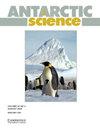南极海洋乔治王岛菲尔德斯半岛湖泊微生物多样性的季节变化
IF 2
4区 地球科学
Q3 ENVIRONMENTAL SCIENCES
引用次数: 1
摘要
位于乔治国王岛的菲尔德斯半岛受到近年来快速气候变暖的影响很大。湖泊是菲尔德斯半岛景观的普遍特征,其中一些被用作南极站的水源。以菲尔德斯半岛7个湖泊为研究对象,探讨湖泊间和季节间浮游植物和浮游细菌群落的差异。我们测量了环境变量,使用高效液相色谱分析色素,并通过16S rRNA基因的高通量测序来检测细菌DNA。构建微生物群落的主要驱动因素是季节(即春季与秋季)。所有湖泊和两个季节的浮游植物类群均以绿藻类为主。确定了各季节的指示菌,其中Flavobacterium、Polaromonas和Oxalobacteraceae是厚冰条件下春季的指示菌,而Frankiales和Verrucomicrobia是无冰夏季后秋季的指示菌。春季的指示物种通常在少营养条件下观察到,而许多秋季的指示物种通常在土壤中发现。湖泊间微生物群落的差异在开放水域期结束的秋季比在冰雪覆盖期结束的春季要小。本研究将作为今后评估水生微生物群落变化的基础。本文章由计算机程序翻译,如有差异,请以英文原文为准。
Seasonal shifts in microbial diversity in the lakes of Fildes Peninsula, King George Island, Maritime Antarctica
Abstract Fildes Peninsula, on King George Island, has been greatly influenced by recent rapid climate warming. Lakes are pervasive features of Fildes Peninsula landscapes, some of which are used as water sources for Antarctic stations. We studied seven Fildes Peninsula lakes to explore differences among lakes and between seasons in phytoplankton and bacterioplankton communities. We measured environmental variables, analysed pigments using high-performance liquid chromatography and examined bacterial DNA through high-throughput sequencing of the 16S rRNA gene. The main driver structuring microbial communities was the season (i.e. spring vs autumn). Chlorophyceae were the dominant phytoplankton group in all lakes and both seasons. Indicator bacteria for each season were identified, including Flavobacterium, Polaromonas and Oxalobacteraceae as indicators of spring conditions under thick ice, whereas Frankiales and Verrucomicrobia were indicator species of autumn following the ice-free summer. The indicator species for spring are generally observed in oligotrophic conditions, whereas many of the autumn indicators are commonly found in soils. There were lesser between-lake differences in microbial communities in autumn, at the end of the open-water period, than in spring at the end of the ice-covered period. This study will act as the basis for future assessments of changes in aquatic microbial communities.
求助全文
通过发布文献求助,成功后即可免费获取论文全文。
去求助
来源期刊

Antarctic Science
地学-地球科学综合
CiteScore
3.60
自引率
6.20%
发文量
42
审稿时长
3 months
期刊介绍:
Antarctic Science provides a truly international forum for the broad spread of studies that increasingly characterise scientific research in the Antarctic. Whilst emphasising interdisciplinary work, the journal publishes papers from environmental management to biodiversity, from volcanoes to icebergs, and from oceanography to the upper atmosphere. No other journal covers such a wide range of Antarctic scientific studies. The journal attracts papers from all countries currently undertaking Antarctic research. It publishes both review and data papers with no limits on length, two-page short notes on technical developments and recent discoveries, and book reviews. These, together with an editorial discussing broader aspects of science, provide a rich and varied mixture of items to interest researchers in all areas of science. There are no page charges, or charges for colour, to authors publishing in the Journal. One issue each year is normally devoted to a specific theme or papers from a major meeting.
 求助内容:
求助内容: 应助结果提醒方式:
应助结果提醒方式:


